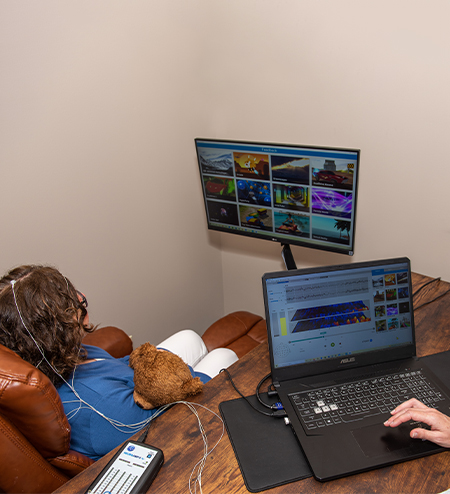 Cozy Up!
Cozy Up!
When you arrive at a neurofeedback session, you’ll cozy up behind a monitor as you sink into a relaxing chair. Bring your lounge clothes and prop up your feet! It’s all about carving out a calming time for your nervous system.
Neurofeedback is the part of the day clients look forward to because it feels so good!
It’s Like a Massage for Your Brain
Connection comes first.
I will ask you some questions about the changes you noticed since your last session, and we’ll compare them to how you typically feel or respond. You’ll have a space to feel heard as you unpack any struggles or stressors from your week and celebrate what went better.
I’ll support you as you discuss how you would like to respond to that tricky person when you see them tomorrow or how you “didn’t lose it” this week with your kids. I’ll normalize how getting eight hours of sleep helps put those bad habits in the back seat. We’ll weave in mindfulness meditation and other calming strategies.
 Next comes Feedback and Mindfulness.
Next comes Feedback and Mindfulness.
Before long, you won’t even notice those electrodes were already placed on your head while we were talking. You’ll select your feedback choice for the day, and your brain takes it from there. Some people like to remain quiet during the feedback portion of the session, and some want to continue connecting. Keeping it light is helpful while your brain does the work.
During the neurofeedback, you’ll let me know the changes you notice in your body and mind as they arise, and I’ll prompt periodic mindfulness scans to engage you in the process entirely.
That pesky tension in your shoulders is gone, and your breath feels even and steady now. You felt a wash of tingly calm down the front of your body. Hands are no longer shaking, and your mind is no longer thinking of 50 things all at once.
Clean up and savor.
Once the electrodes are off, we’ll deepen the changes you feel. You’ll set an intention based on the themes discussed and what you practiced during the session.
As you leave the office, you feel lighter, brighter, and ready for your day. There’s a bounce in your step and a smile on your face.
 Let’s hear from a client.
Let’s hear from a client.
After adding neurofeedback in two sessions, one client said the following:
“Hello. I wanted to check in. I am doing well today. I have noticed that I feel calm and capable. Even if there are many things to do, I don’t feel frantic or over-stressed. It feels manageable.
There is also that sense of… “It will be fine, and one thing at a time.” It’s Okay if it isn’t all done. Not overwhelmed or ruminating. Just calm action. I also feel better able to take action – it doesn’t feel as big/monumental. And I feel calmer and more focused yet energized to do it. I see that as better from a depression and anxiety standpoint.
Thank you. Will see you next week.”
Neurofeedback is like going to the gym for your brain!
Neurofeedback is a super cool form of biofeedback that gives your brain repeated practice to regulate numerous symptoms all at once.
Check out the Neurofeedback FAQ below to learn more.
Neurofeedback FAQ
What issues can neurofeedback help address?
The brain operates so many functions. Here are some common ones we might target:
- anxiety: stress reactivity, worry, panic, fear, overwhelm, phobias
- improving mood
- physical and mental calming
- focused and sustained attention
- organization and planning
- motivation and energy
- impulse control
- body and emotional awareness
- sleep: falling asleep, staying asleep, deep sleep, nightmares
- brain fog or feeling numb or disconnected
- pain or headaches
What DON’T you treat using neurofeedback?
The following are not within my specialty areas or scope of practice:
- epileptic seizures
- severe migraine
- severe brain injury
- schizophrenia, schizoaffective, or other thought disorder
- Parkinson’s, dementia, MS, or another neurogenerative disease
- mania or bipolar disorder
- addiction
- active suicidal thoughts or self-harm
- crisis
When is neurofeedback helpful?
Neurofeedback complements other therapy methods and is an excellent option to add when there hasn’t been a substantial change with other approaches or for someone who wants something different than traditional talk therapy.
I often see clients for a series of sessions alongside appointments with their primary therapist (but not on the same day if using insurance).
Who is a good fit for neurofeedback?
Where do you put the electrodes?
How does neurofeedback work?
First, no electricity goes through the electrodes – this isn’t ECT. The electrodes show moment-to-moment changes in your brain activity on a screen in front of you.
Your brain sees its activity mirrored back to itself (the feedback); it’s like how dancers learn to adjust their posture and steps with the help of a mirror. The brain learns to self-correct through repeated practice and repetition.
If there is too much or too little brain activity, the screen whites out momentarily, and your brain quickly learns to make minor adjustments to make the screen clearer again. This repeated “exercise” allows your brain to learn to self-regulate on its own over time, toward balanced and calm brain functioning as its new default.
Is it hard to learn, and what if I do it wrong?
I heard you hold a bear in sessions – how come?
What kind of neurofeedback will we be doing?
Neurofeedback has been around since the 1970s. We use Infra-Low Frequency (ILF) Neurofeedback, a procedure developed in 2006. To start, ILF does not require brain scans or a qEEG (Quantitative Electroencephalogram). We are also not trying to change your brain waves like other neurofeedback systems.
We’ll measure and track changes in your symptoms over time that guide what we do in each session. It’s a very collaborative process.
Synchrony Neurofeedback is added for additional emotional calming and Alpha-Theta Neurofeedback is added to assist with letting go of trauma and habitual thought or behavioral patterns.
How often and how long do we do neurofeedback?
Neurofeedback is most effective if done twice weekly (or once a week at a minimum) because all brains need regular practice to hold changes, just like going to the gym.
The typical number of sessions needed is 25. We taper your appointments from there to sustain progress. Sometimes more sessions are required to hold changes before tapering for clients with chronic or complex symptoms. We will discuss and determine this together.
How long have you been doing neurofeedback and have you done it?
I received training about five years ago and have loved adding this method for clients who are interested and are a good fit.
Yes! Throughout my training, I hooked up and completed a series of sessions myself. Tension headaches are rare for me now. It helped reduce stress reactivity, and my sleep improved significantly, to name a few things.
Weird Works Wonders!
I agree – having electrodes stuck to your head during a therapy session is weird!
I’ll be there through every step of the process and can answer any questions you may have.
If you’re ready to try something new that’s effective and creates noticeable and fast relief that sticks, reach out today.
Let’s schedule your 15-minute free phone consultation to see if individual therapy with neurofeedback is a good fit for you.

